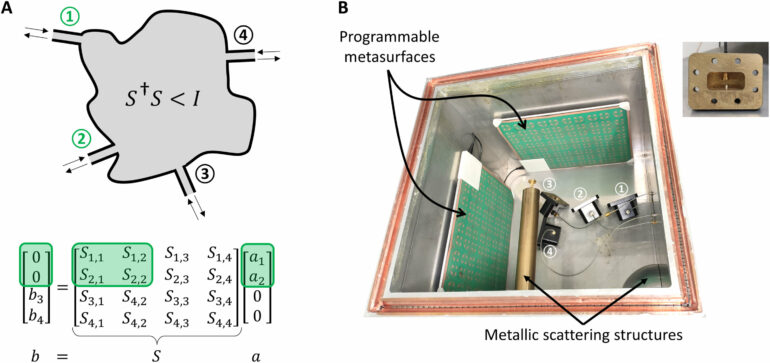Building off a breakthrough “anti-laser,” a team of researchers has developed a system that can direct light and other electromagnetic waves for signal processing without any unwanted signal reflections—an innovation that could advance local area networks, the field of photonics, and other applications.
The results, led by A. Douglas Stone of Yale and Philipp del Hougne of University of Rennes in France, are published in Science Advances.
A little more than a decade ago, Stone led a team in the creation of the anti-laser, or “coherent perfect absorber” (CPA). Instead of emitting a beam as a laser does, an anti-laser absorbs input light with the same precision.
In a laser, light bounces back and forth between two mirrors, each time passing through an amplifying material—known as the “gain medium”—such as gallium arsenide. Because the light is of a specific wavelength, it creates a feedback that increasingly gains in intensity. In a typical light source—an everyday lightbulb, for instance—atoms radiate independently and create light of many different wavelengths, and light goes in many directions as a result. In lasers, though, atoms radiate at the same frequency and in the same direction, creating a concentrated beam of a single wavelength.
The difference in the anti-laser is that instead of using an amplifying material, it uses one that absorbs the light—that is, a “loss medium.” In its simplest version, the anti-laser splits a single laser beam into two and directs the two beams into each other, meeting at a paper-thin silicon wafer. The light’s waves are precisely tuned to interlock with each other and become trapped. They then dissipate into heat.
For their most recent work, the researchers built off this concept and developed a device based on what they call “reflectionless scattering modes” (RSMs).
“We asked if there is some principle like this where we can guide light instead of transducing it into another form of energy,” said Stone, the Carl A. Morse Professor of Applied Physics and Physics. “Because with optical fibers and modern photonic circuits, guiding light and not having any of it reflect back is extremely valuable.”
From there, they developed the device that, instead of absorbing the waves, redirected them to specific channels. Stone worked on the theoretical side of the project, while Philipp del Hougne of University of Rennes in France built the actual device.
“Instead of having it all transduced, it could either all go into our chosen output channels or some of it could be absorbed and the rest go into the output channels,” Stone said. “In the next step, we want to make a similar device where the absorption is negligible, so that all of the energy is efficiently routed to perform its information or sensing function. There is great interest in such technologies to reduce the power consumption of cell phone networks, for example.”
The device eliminated signal reflections, which have long been a problem for signal routers, a pivotal ingredient of modern nanophotonic and radiofrequency networks. Besides causing a loss in signal power, such reflections can cause devastating unwanted reflected-signal-power echoes in the network.
More information:
Jérôme Sol et al, Reflectionless programmable signal routers, Science Advances (2023). DOI: 10.1126/sciadv.adf0323
Citation:
Building off the ‘anti-laser,’ researchers create a device that directs waves (2023, January 26)



